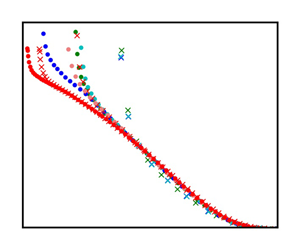Article contents
Outer scaling of the mean momentum equation for turbulent boundary layers under adverse pressure gradient
Published online by Cambridge University Press: 28 February 2023
Abstract

A new scaling of the mean momentum equation is developed for the outer region of turbulent boundary layers (TBLs) under adverse pressure gradient (APG). The maximum Reynolds shear stress location, denoted as  $y_{m}$, is employed to determine the proper scales for the outer region of an APG TBL. An outer length scale is proposed as
$y_{m}$, is employed to determine the proper scales for the outer region of an APG TBL. An outer length scale is proposed as  $\delta _e - y_{m}$, where
$\delta _e - y_{m}$, where  $\delta _e$ is the boundary layer thickness. An outer velocity scale for the mean streamwise velocity deficit is proposed as
$\delta _e$ is the boundary layer thickness. An outer velocity scale for the mean streamwise velocity deficit is proposed as  $U_e - U_{m}$, where
$U_e - U_{m}$, where  $U_e$ and
$U_e$ and  $U_m$ are the mean streamwise velocities at the boundary layer edge and
$U_m$ are the mean streamwise velocities at the boundary layer edge and  $y_{m}$, respectively. An outer velocity scale for the mean wall-normal velocity deficit is proposed as
$y_{m}$, respectively. An outer velocity scale for the mean wall-normal velocity deficit is proposed as  $V_e - V_{m}$, where
$V_e - V_{m}$, where  $V_e$ and
$V_e$ and  $V_{m}$ are the wall-normal velocities at
$V_{m}$ are the wall-normal velocities at  $\delta _e$ and
$\delta _e$ and  $y_{m}$, respectively. The maximum Reynolds shear stress is found to scale as
$y_{m}$, respectively. The maximum Reynolds shear stress is found to scale as  $(\delta _e - y_{m}) U_e \,{\rm d}U_e/{{\rm d}x}$. The new outer scaling collapses well the experimental and numerical data on APG TBLs over a wide range of Reynolds numbers and strengths of pressure gradient. Approximations of the new scaling are developed for TBLs under strong APG and at high Reynolds numbers. The relationships between the new scales and previously proposed scales are discussed.
$(\delta _e - y_{m}) U_e \,{\rm d}U_e/{{\rm d}x}$. The new outer scaling collapses well the experimental and numerical data on APG TBLs over a wide range of Reynolds numbers and strengths of pressure gradient. Approximations of the new scaling are developed for TBLs under strong APG and at high Reynolds numbers. The relationships between the new scales and previously proposed scales are discussed.
JFM classification
- Type
- JFM Papers
- Information
- Copyright
- © The Author(s), 2023. Published by Cambridge University Press
References
REFERENCES
- 15
- Cited by



